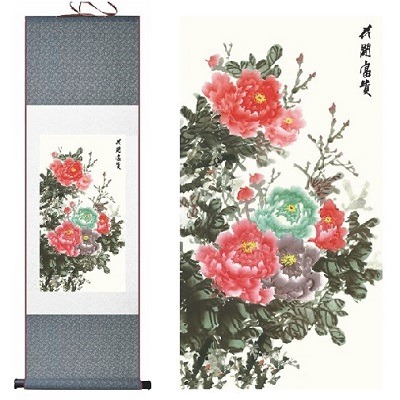
Chinese silk paintings are made on silk and involve the artist using a brush dipped in black or colored ink. The materials used are similar to that of Chinese calligraphy. Silk must be stretched by the artist and then dyed. Then a layer of gutta, which is similar to rubber cement, is placed on the silk so that boundaries are created to limit the free flow of silk. After the gutta dries, the artist then begins to paint on the silk. Once paint is applied to the silk, it cannot be altered, so the craft requires patience and careful precision of strokes. After the painting is completed, it can be hung on a scroll for display. Most commonly pine soot is used to create the ink used in Chinese silk paintings.
Some Chinese historians believe that silk paintings were created during the Warring States period; they were placed in tombs in order to assist the dead in entering the afterlife. Originally, silk was used only for calligraphy, which was considered the highest art form in China, but later Chinese artisans began to paint landscapes, koy fish, maidens, dragons, daily life, cranes and plum trees.
Two approaches to silk painting exist:
Gongbi (gong means “meticulous” and bi means “to write”) – This technique involves using highly detailed brush strokes.
Shuimo (shui means “water” and mo means “ink”) – In this approach to silk painting, only black ink is used in different variations; it came to prominence in the Tang Dynasty and relies on more impressionistic techniques
Three types of Chinese paintings
Landscape – focuses on scenic backdrops of mountains, lakes on an epic scale
Figure- focuses on the important people or the daily lives of commoners
Bird and Flower- focuses on the flora and fauna of Chinese nature
Famous Chinese Silk Painters
He Xiangning – Born in Hong Kong, He Xiangning would later go to Japan where she studied art at the Ueno School of Art. She is renowned for her silk paintings of plum blossom trees, which are supposed to represent courage and purity in Chinese culture. She also studied in the Lingnan School of Painting, which literally translates to South of the Ranges. South of the Ranges refers to the basins Tayu, Qitian, Dupang, Mengzhu, and Yuecheng, which separate the Yangtze River from the Pearl River, which is in the Guangdong Province.
Gao Qi-Feng – Gao is a native of the Guangdong province and he also went to study painting in Japan. He is considered one of the three masters of the Lingnan School of Painting.

